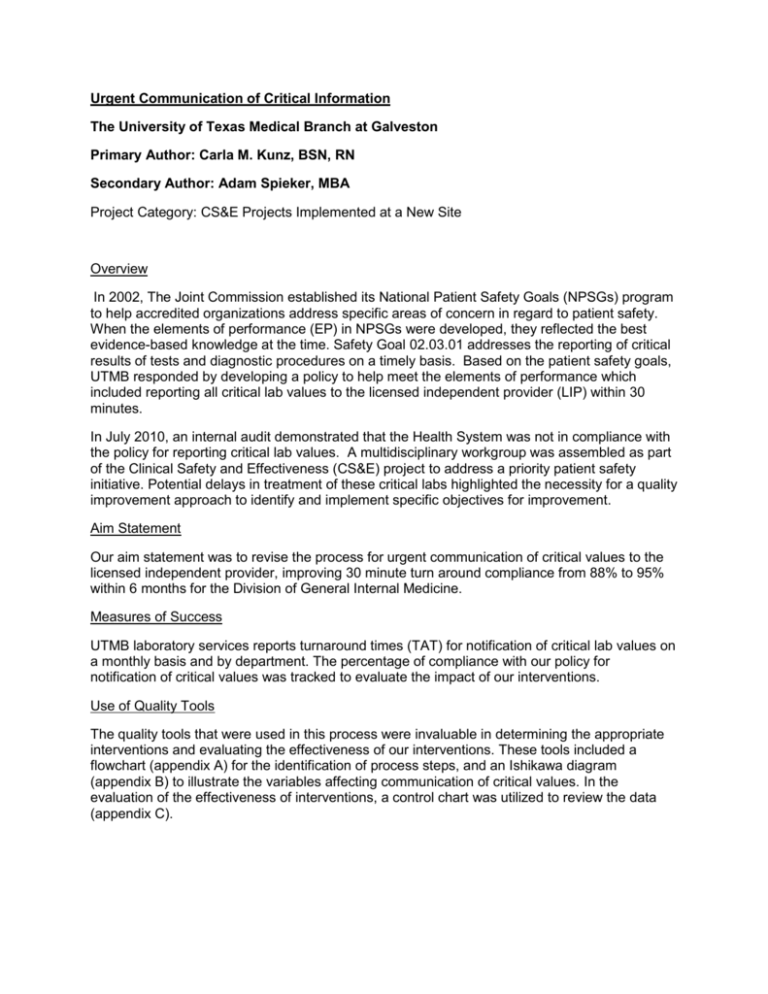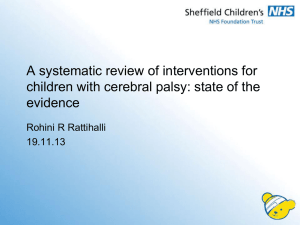must be single-spaced, one-inch margins, 11 pt Arial font
advertisement

Urgent Communication of Critical Information The University of Texas Medical Branch at Galveston Primary Author: Carla M. Kunz, BSN, RN Secondary Author: Adam Spieker, MBA Project Category: CS&E Projects Implemented at a New Site Overview In 2002, The Joint Commission established its National Patient Safety Goals (NPSGs) program to help accredited organizations address specific areas of concern in regard to patient safety. When the elements of performance (EP) in NPSGs were developed, they reflected the best evidence-based knowledge at the time. Safety Goal 02.03.01 addresses the reporting of critical results of tests and diagnostic procedures on a timely basis. Based on the patient safety goals, UTMB responded by developing a policy to help meet the elements of performance which included reporting all critical lab values to the licensed independent provider (LIP) within 30 minutes. In July 2010, an internal audit demonstrated that the Health System was not in compliance with the policy for reporting critical lab values. A multidisciplinary workgroup was assembled as part of the Clinical Safety and Effectiveness (CS&E) project to address a priority patient safety initiative. Potential delays in treatment of these critical labs highlighted the necessity for a quality improvement approach to identify and implement specific objectives for improvement. Aim Statement Our aim statement was to revise the process for urgent communication of critical values to the licensed independent provider, improving 30 minute turn around compliance from 88% to 95% within 6 months for the Division of General Internal Medicine. Measures of Success UTMB laboratory services reports turnaround times (TAT) for notification of critical lab values on a monthly basis and by department. The percentage of compliance with our policy for notification of critical values was tracked to evaluate the impact of our interventions. Use of Quality Tools The quality tools that were used in this process were invaluable in determining the appropriate interventions and evaluating the effectiveness of our interventions. These tools included a flowchart (appendix A) for the identification of process steps, and an Ishikawa diagram (appendix B) to illustrate the variables affecting communication of critical values. In the evaluation of the effectiveness of interventions, a control chart was utilized to review the data (appendix C). Interventions Upon careful review of the process and variables for communication of critical lab values utilizing the tools referenced above, there were several opportunities for improvement that were targeted. Interventions were selected that were realistic to achieve within the timeframe of the project (6 months). 1. A Standardized data entry form for the development of on-call schedules was initiated to eliminate inconsistent information on the schedules. These inconsistencies caused reported variations in interpretation of the data and subsequent errors in data entry and/or time-consuming efforts spent to clarify the information. 2. Accountability for entering on-call schedule into AMCOM© (communication software utilized by UTMB) shifted from operator services to a department liaison. A partnership between supervisor of operator services and the administrator for the department of Internal Medicine was crucial in the development of strategies to shift accountability which included training by/of their respective staff members. 3. A policy was developed describing the process of responding to pages reporting critical lab values. Embedded in this policy is a well-defined chain of command and expected timeframes for response. This new policy was communicated to the faculty and residents of General Internal Medicine utilizing multiple dissemination strategies. Results The results of this process improvement initiative were demonstrated in a Statistical Process Control (SPC) chart. The control chart reflected statistically significant increases in compliance starting in July 2010 with the publication of the audit results across UTMB and again in March 2011 with the start-up of the multidisciplinary CS&E Team. After implementing the changes and interventions, the results showed an improvement in the process from about 88 % compliance, with a wide variation in the first half of 2010, to a mean of 95% compliance with minimal variation. Within the 6-month project timeline, notations were made of specific interventions. The overall results revealed improved times, less variation, and indications of sustainability. The results for the months following the project continued to demonstrate sustained improvement. Revenue Enhancement/Cost Avoidance/Generalizability After determining our changes were successful, we decided the project was ready for implementation across the institution. Using the Institute for Healthcare Improvement Spread Planner for guidance, we identified leadership, set up an infrastructure and strengthened the social system for spread. The project is aligned with the institutional goals of improving quality and safety with continuous improvement, promoting a culture of high reliability and trust and advancing clinical efficiency by strengthening our support systems. The following interventions were put in place: 1. Identified that the Chief Quality Officer would be the executive responsible for the spread and that the Manager of Risk Management would be responsible for the day to day spread activities. 2. Identified that the target population for the adoption decision would be the chairs and administrators of the School of Medicine Departments. 3. Analyzed the pilot interventions to identify that switching accountability for entering oncall schedules into AMCOM had the most impact on the pilot project and was the most spreadable component of the project. 4. Developed a presentation to demonstrate pilot area successes and proposal for spread. 5. Identified champions at the grass roots level and established two way communications between the champions and target population. 6. Upgraded the existing software to the latest version for hardening of the system and ease of use. 7. Provided group training for entering on-call information into the software system which encouraged communication among the targets and identification of common problems/ issues. 8. Provided messengers at the training sessions: the person formerly responsible for the task of entering information and the risk manager who related the relevance of the task to patient safety and satisfaction. 9. Provided one-on-one training by request to foster support of the targets. There are many benefits of this project, including improved quality patient care and safety, improved continuity of care, increased employee satisfaction, and decreased liability for the institution. The project aligns with the institutional goals of promoting a culture of high reliability. Conclusions and Next Steps We will continue to monitor the data to verify we are meeting our goals and meet regularly with the project champions and messengers to resolve issues. Appendix A: Flowchart Appendix B: Ishikawa Diagram Appendix C: Control Chart SPC Chart of Percent Critical Values in Compliance







